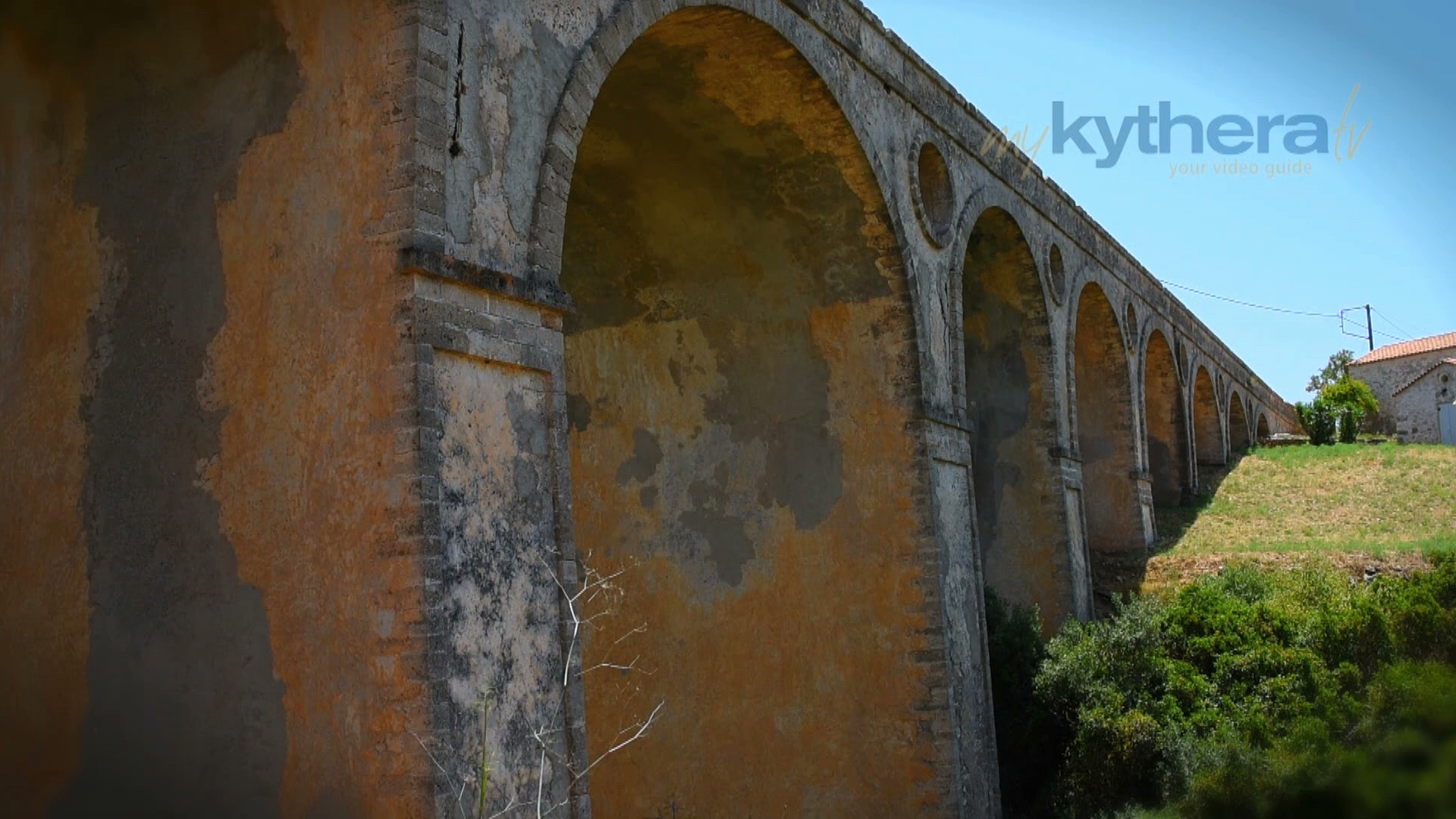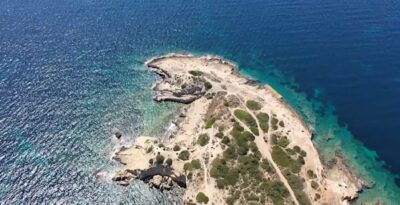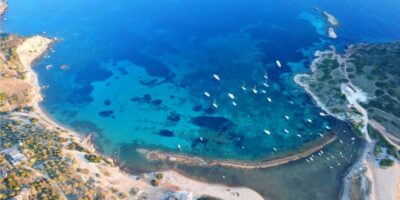These are the best sightseeing attractions with a heavy historical background from middle ages up to modern age. These places to visit involve, pirates, architecture, local art and to some of them, walking is the only means to reach them. Since Kythera is a big island, we recommend to hire a car for your transportation, since some of these places are remote.
The Incredible Moudari Lighthouse
The Moudari lighthouse is an iconic monument on the island of Kythera
Moudari is the lighthouse situated at the northernmost point of the island, at cape Spathi. It was built under the British rule and with a height of 25 meters is the largest lighthouse built by the British in Greece.
It was constructed in 1857 with the purpose of facilitating the navigation in the straits between Kythera and Elafonisos. Adjacent to the lighthouse is the “simatorio” or “simatologio” (signal-house) that informed passing ships with the use of flags.
Once you get all the necessary instructions and information at the village of Karavas, you should definitely visit it. Go up the lighthouse and take a look at the stunning view which in clear days may encompass the entire Laconic bay, from Cape Maleas to Cape Tenaro.
The Fortress of Chora
“Eye of the Greek Seas” was the name given to the Chora fortress due to its strategic position
Kythera’s most iconic monument is undoubtedly the castle of Chora. The castle or “Fortezza”, as it is called, was built in the 13th century when Kythera was dominated by the Venetians.
The “Eye of Crete” as it was also called due to its strategic position, served as a strategic point for the observance of ships simultaneously on three seas – the Ionian, Aegean and Cretan. It was built over different phases of the island’s history, but the biggest and main part including the facade was built in 1503 by the Venetians, who repaired and reconstructed it.
The Venetian emblem of the lion of St. Mark used to be on that front wall, but it was destroyed along with the Nobility Book and the coats of arms by the French in 1797. Outside the fortress there is a second wall to the north, surrounding Klistos Vourgos with many churches and houses. There are several cannons in the castle, dating from the Venetian, the Russo-Turkish and the English period.
Water Springs of Amir Ali
After a relaxing walk from Karavas, one reaches the Amir Ali sources that never dry up
Amir-Ali’s ravine is located at the evergreen village of Karavas, in the northern part of the island, a few kilometers from the larger village of Potamos. Karavas is built on a verdant ravine with all kinds of trees.
There you encounter many sources never stop gushing cool water. Among the most famous is the source of Amir Ali, the Portokalia, the Keramaris and sources of manganese. The second takes its name from an orange tree, which according to tradition produced a hundred thousand oranges.
As you descend towards the springs of Amir Ali, you will meet the old settlement Mavrogiorgiannika which deserted and silent, stands as a spectator on the green landscape. Recently there have been restorations of old houses there, creating real jewels of architecture. A relaxing walk along the trail that leads to the springs and some moments of rest there, offer a unique sense of well being.
Fortress Town of Paleochora
Paleochora, the Byzantine capital of Kythera, is a stunning archeological treasure
The ruined fortress of Paleochora is one of the most important archaeological sites of Kythera, the island’s Byzantine capital. It was built by Monemvasians in the12th century and was named the city of Agios Dimitrios. It is located on the north side of the island, in the middle of a natural fortress in a deep rough canyon surrounded by huge rocks.
The canyon ends at the coast of Kakia Langada. It is a perfect example of 13th century architecture, similar to Mystras and Monemvasia. Paleochora is fortified and lower than the surrounding hills but it is invisible from the sea, so as to be protected from the many pirate raids that were plaguing the island for many years.
Despite those precautions, the terrifying pirate Barbarossa managed to find and destroyed it in 1537, selling all the inhabitants as slaves. From that time, the city has never been reconstructed because it was considered a place of bad fortune. This wonderful site is full of fine Byzantine churches and chapels, and all have remains of impressive wall paintings and frescoes.
The Katouni Bridge
With 13 perfectly symmetrical arches and 12 round openings, the Katouni bridge is a very impressive site in Kythera
The Katouni stone bridge is one of the most impressive sites in Kythera, in the Kato Livadi area. It counts almost 180 years and has a length of 110m and a height of 15m. Its 13 arches are in absolute symmetry and its monumental size dominates the Livadi area.
It has the particularity of counting on a series of holes between its arches and now it is known that they served for lessening the stiffness of the bridge and making it more balanced. Despite the passing of time, the design and the excellent construction of Katouni Bridge are remarkable architectural achievements.
Built in the period of British rule, it is the largest stone bridge in Greece. Built in order to form part of the road connecting the capital to Avlemonas, it was the biggest building project of the British in Kythera.
However, this road was never completed as the British left in 1864 after the union of the Ionian islands with Greece. Due to its marvellous architecture, the bridge can sustain weights far heavier than the ones it was planned for, and today it is one of the island’s most noteworthy sites.
Agia Sofia Cave
The Agia Sofia cave is a spacious underground cave rich in stalactites and stalagmites
The impressive Agia Sofia Cave is one of three caves bearing the same name, a few kilometers outside the quaint village of Milopotamos, going towards Limniona beach. The cave’s name refers to the adoration of Saint Sofia, whose namesake chapel is found inside the cave.
The entrance to the cave is adorned by a chancel carved in the rock with very significant 13th century iconography, in excellent condition. The cave extends to an area of approximately 2000m² but visitors can only see a 200m section. In addition to the murals there is also a later church dedicated to Agia Sofia.
Moving deeper into the cave you’ll see an impressive spectacle of stalactites, stalagmites and color variations due to the morphology of the region’s rocks. The average temperature in July is 16 °C and humidity reaches 73%.
The cave is open to visitors during the summer months and the helpful guides will inform you about its history and about Kythironiscus Paragamiani, the little isopod that lives only here.










